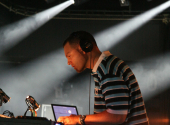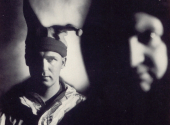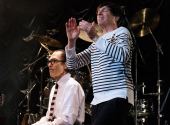
Milestones in Music History #57: Einstürzende Neubauten, Industrial at Its Best
In our previous episode, Coil led us through the world of dark ambience and the occult, and the unusual and intriguing side of contemporary music. In the same decade in another part of Europe, a group was shaping the roughness of sound, taking experimentation to stratospheric levels and changing the essential nature of music. Today we're talking about Einstürzende Neubauten, from West Germany.
Who knows what it must have felt like to live in a city where you could only explore half of it, with a wall dividing not only streets and houses but also ideas, cultures and exchanges of opinions. It was a forced division to which the human spirit simply had to get used. And most probably it was this situation that triggered a major push towards art and experimentation.
However, the situation in the two halves was not the same: in East Germany, radio from the West certainly circulated and rock music arrived via the classics like the Beatles and the Rolling Stones, and thus bands began to form in the area. But after realising the anti-establishment policy and subversiveness of rock, the GDR banned it, changing the rules and allowing only new "clean" music.
The new music had to be exclusively in German and promote positive socialist educational ideas and ideals. Although in German, song lyrics were controlled and some bands from the area, such as Renft and Puhdys were banned – the latter were very mainstream at the time, along with Karat and Stern-Combo Meißen.
Some underground groups did develop, however, including some punk rock bands, such as Feeling B, and others that tended towards new wave, such as Sandow. Schlager music was in vogue, and even classical music was approved of, in particular, Johann Sebastian Bach, who was born in Eisenach, which was part of East Germany. As for jazz, it was at first banned but then eventually accepted as a form of popular music, perhaps because they realised it was not so dangerous after all.
Far different was the situation in West Berlin, to which many musicians who had escaped from the East had landed (including Veronika Fischer and Nina Hagen) and where there was a subculture dense with all sorts of musical and artistic phenomena. The nightlife in West Berlin seemed never-ending; it ranged from discos and clubs offering live concerts to the scattered restaurants and gay bars that stayed open until morning.
This was where the new wave had taken root in the late 1970s, the so-called Neue Deutsche Welle; but West Berlin is also the place where David Bowie decided to further part of his musical career – the more experimental side – by living there for a couple of years, from 1976 to 1978. And indeed, the environment offered plenty of scope for musical experimentation. But to what extent?
This became evident on the 1st of April 1980 by Einstürzende Neubauten at the Moon Club, a well-known West Berlin venue, where they appeared before the public for the first time. The first members included Blixa Bargeld and N. H. Unruh (the founders of the band), Gudrun Gut, Beate Bartel (the two of them then left the band to form their group, Mania D.) and the multi-instrumentalist and at the time still underage Alexander Hacke.
Their performances were noted for their extremity in experimentation: pure industrial made partly with musical instruments, partly with drills, metal objects, electronic devices and instruments made by them, and sound obtained from the destruction of objects during live performances. A splendid ruckus.
1981 was the year that percussionist F.M. Einheit, who had previously been part of the Hamburg post-punk band Abwärts, joined the band. It was also the year of the release of their first studio album, Kollaps. An album that definitively marked territory; a riot of sounds and noises that creates a mix of punk, noise and industrial, coexisting in skillful harmony.
The album also features "Jet'M", a cover of the famous song "Je t'aime... moi non plus" by Serge Gainsbourg, but pretty much completely revisited. To sum it up, it wasn't exactly what you would define as a "catchy" record, and not suitable for the faint of ear. Indeed, it was a slap of experimentation and innovation that had hardly been experienced before.
Soon afterwards, another member of the Abwärts, Mark Chung, also joined the group, and sometime later, in 1983, the band released their second album, Zeichnungen des Patienten O. T. (Drawings of Patient O. T.). Oswald Tschirtner was a schizophrenic psychiatric patient who had been referred to drawing by psychiatrist Leo Navratil and was supervised by him.
The title of the album refers to the title of Navratil's book and is, if at all possible, even more experimental than its predecessor. Apart from metallic and electronic sounds, the group introduced the use of sampling, found sounds and even some hints of melody. In the same year, Bargeld joined the group The Birthday Party, which included Nick Cave and Mick Harvey, while keeping commitments with his Neubauten.
Perhaps one of the band's most significant and expressive concerts was the one held the following year, at the Institute of Contemporary Arts in London, where they were musical guests of the calibre of Genesis P-Orridge and the British avant-garde electronic musician Francis John Tovey, aka Fad Gadget. The concert, entitled The Concerto for Voices and Machinery, consisted partly of breaking out the venue with jackhammers and drills.
The following year in 1985, their third studio album was released, and with it, something began to change. If on the one hand, Halber Mensch (Half Person) maintained the powerful and industrial imprint that had now become the band's trademark, on the other hand, the sound became more refined in the melody.
Even in Bargeld's singing, he no longer abandoned himself to experiment with sound with screams and tone changes but was oriented more towards lyrical compositions and more structured melodies. But it remains one of the most important records of the industrial scene and a masterpiece of composition.
The next two albums, Fünf auf der nach oben offenen Richterskala (Five on the open-ended Richterscale) in 1987 and Haus der Lüge (House of the Lie) in 1989 were still great successes for the band even overseas. Fünf auf der nach oben offenen Richterskala combined dark and ambient tones and experimentation, while Haus der Lüge confirmed their industrial and electronic sound, but with increasingly frequent melodic inserts, even in the vocal parts.
These were the most experimental, exuberant and controversial years of the group, in which the search for a concrete sound reigned supreme, achieving results that no other experimental band had ever achieved. Already with their sixth album, Tabula Rasa, released in 1993 – a very clear case of nomen omen – the group abandoned the experimental key to dedicate themselves more to electronics and became musically softer.
However, they had already achieved what they wanted to achieve, and nothing and no one in the world could have cancelled or forgotten it. Einstürzende Neubauten continues to be present on the scene today and to amaze its audience: only a month ago they released their thirteenth studio album, Rampen (apm: alien pop music) and the band will tour Europe in the autumn.
A group that has inspired the most varied artists in the industrial and new wave fields, but actually through almost all music genres, and which laid the foundations for the musical experimentation of today. To find a similar level of experimentation we have to move to California in the 90s, where the prodigious DJ Shadow, the protagonist of our next episode of Milestones, made his first moves.
How has the historical and political situation influenced musical phenomena throughout history? How important is the place where an artist lives and produces? What type of experimentation today can be compared to that carried out by Einstürzende Neubauten? And is there anyone even more extreme than them?
Leave your opinion in the comments below!
If you have found an error or typo in the article, please let us know by e-mail info@insounder.org.





